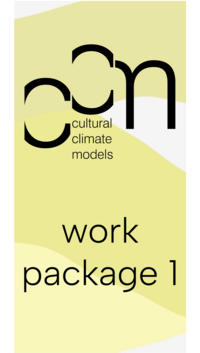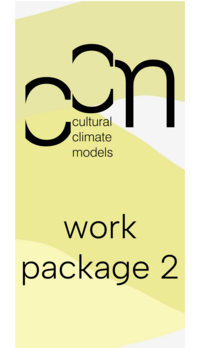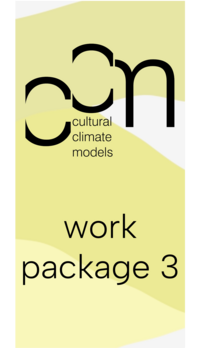Cultural Climate Models
Cultural climate models explore scenarios and engage in ethically charged debates about climate futures. Through a combination of prediction, prescription, and speculation, they foreground aspects of climate change that scientific models tend to elide. They show, for example, how climate change impacts on individuals and their relationships with others, and how it raises complex questions around intergenerational justice. The project “Just Futures? An Interdisciplinary Approach to Cultural Climate Models“ (CCM) comprises three interlinked work packages:
WP1 | Literary Modelling

Climate fiction has gained much recent interest as a way of exploring environmental crisis scenarios. But how do other genres, such as theatre and the personal essay, model climate futures? Combining methods from ecocriticism and the environmental humanities, we analyse how our texts reveal the ethical and experiential dimensions of modelling climate change. Concepts and keywords emerging from WP1 inform the work of the other two Work Packages.
This WP focuses on textual modelling of climate futures in two contemporary genres which have largely been neglected by researchers: theatre and the personal essay. While theatre has for some time addressed challenges of climate change communication, it has recently become concerned with imagining the future and the ethics of human reproduction. Recent theatre highlights the increasing rupture between generations amidst pressing concerns of intergenerational justice. The personal essay, written from a parental perspective, has also emerged as a way of addressing the ethical and existential ramifications of climate change. Its formal flexibility allows autobiographical reflection, reportage, and philosophical argument to be combined. We explore especially how these genres model ‘posterity’ i.e. relationships between parents and children and intergenerational justice. This modelling involves description (‘models of’) through selecting and exploring affective and social factors that will inform how the climate crisis plays out. It also involves implicit or explicit prescription (‘models for’) by suggesting that some futures are more desirable and sustainable than others, and that we should take up particular ways of being to achieve them. We have so far produced conference papers on the ethics of parenting and procreation in a climate crisis, and on future imaginaries of sea-level rise and flood risk. Central to our research is the relationship between technical models / projections, and individual and communal human experience. (David Higgins & Julia Hoydis)
WP2 | Multimodal Modelling

How are climate futures imagined on social media? To answer this question we employ digital methods in science and technology studies, corpus linguistics, and qualitative multimodal discourse analysis. We take both technical and cultural aspects into account: the specific platform conditions and functions that shape how people communicate online about climate-related issues, as well as how these issues are represented linguistically and visually.
Social media platforms and their users share a paradoxically dependent relationship; on the one hand, social media platforms are reliant on content created by users. On the other, users are bound by platforms’ affordances, over which they have little control but which they must accept to participate. Internet communication about climate change and related issues is thus shaped by both creativity and agency of the users and opportunities and constraints offered by the medium itself. This presents multiple possibilities for (semiotic) positioning and engagement, through multiple communication modes such as text, audio, pictures, or video formats. Social media users compile their contributions in an environment of intertextuality and social and symbolic reference that amplifies certain contents and diminishes others. Investigating the social media modelling of climate futures requires studying the distribution, recurrence and connectivity of posts with a quantitative approach. It also involves examining the concrete linguistic and visual phenomena and practices users employ for their communicative ends with qualitative methods. We draw on a new dataset collected between November 2023 and November 2024 on Instagram, TikTok, and Twitter/X. Our thematic corpus includes the broad search term “climate change”, an event-specific term “COP”, as well as three solution-oriented terms: “NetZero”, “veganism”, and “antinatalism”. The latter represents an experimental comparison point between trends in contemporary literature (identified in WP1) and social media discourse. We analyse macro- and microscopic dimensions of discourse, aiming to determine differences in platform (i.e., what kind of posts are usually found on which provider) and trends of certain posts over time (i.e., preference of certain colour schemes, topics, or post types at certain times). This includes lexical preference specific to certain topics, usage of metaphors in both text and visual, and cultural practices of positioning that are frequently employed for certain purposes. (Warren Pearce & Carolin Schwegler)
WP3 | Critical Modelling

How do fiction, literary criticism and education engage with, and critically reflect on, the practice of modelling? Is it explicitly mentioned or implicitly used, in book reviews or teaching materials? Through research reviews, textual analysis and empirical surveys, WP 3 wants to find out more about the idea of ‘critical modelling’.
This WP complements the project by assembling instances of ‘critical modelling’ – in fiction that explicitly mention models and modelling, but also in professional as well as lay literary reviews and in pedagogical work on just futures. Criticism and pedagogical texts are understood as meta-communications about the functions of literature and social media, and they do their own kind of modelling when describing texts as ‘blueprints’ or characters of ‘role models’, or when using literary and other texts in educational settings that follow specific ‘competence models’. We look at the work and reception of frequently cited cli-fi scholars and non-academic reviews in print and online sources, as well as educational works ranging from theoretical concepts to the policy level and practice-oriented teaching materials, and we explore the manifold and often incommensurate usages of the terms ‘model’ and ‘modelling’ in fiction, criticism and educational literature in order to reflect on their meaning in varying contexts. Readers and writers of fiction may describe a text as an archetype or paradigmatic case; novels and teaching materials may explicitly engage with scientific models; and literary analyses and teaching materials may follow theoretical and pedagogical models of literacy or competence. We ask: how can these diverse fields connected by way of a better understanding of the semantic nuances of the notion of model(ling)? We have begun our work with a number of systematic and critical reviews, first distributed as working papers and currently in preparation for publication, as well as analyses of literary texts and teaching materials. As a next step, we will synthesise our findings in a joint publication and also translate them into materials for teacher education and in-service teacher training. (Roman Bartosch & Jens Gurr)

